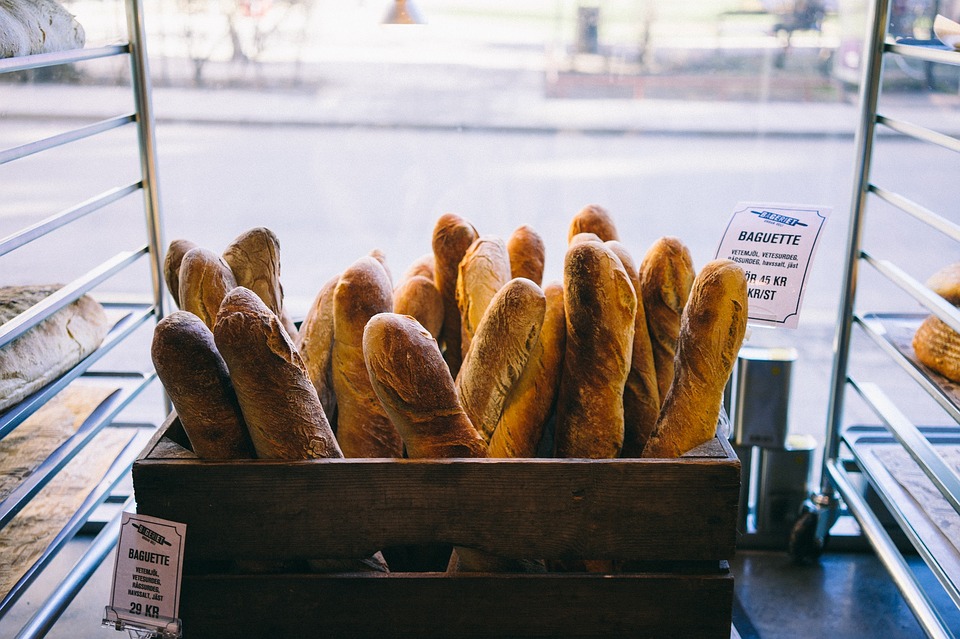Miette par Miette (Crumb by Crumb): Your Quick Guide to French Bread Posted by mtaulier on Jan 27, 2014 in Culture
In the last post, I relayed a humorous anecdote about ma petite mésaventure (my little misadventure) with a baguette. Since France is known for its bread, I thought we could take a moment to explore the wonderful world of le pain Français (French bread). This might come in handy should you ever visit France and it might even be useful if you currently live near une boulangerie (a bakery) that specializes in French bread.

When Anglos think of French bread, the image that typically pops into their head is probably that of la baguette (the stick/rod). A long, thin stick of white bread, la baguette is the most widely consumed type of bread France. The French stereotype of an old man wearing a beret with a cigarette dangling from his mouth and riding his bicyclette (bicycle) usually has une baguette sous le bras (a baguette under his arm). Be aware that the French traditionally bake their bread without preservatives. This means that when you buy a baguette, it is meant to be consumed in its entirety—or almost—le même jour (that same day). Should you return to your uneaten baguette the following day, you will find a hard stick that can be used as a weapon to fend off intruders. Wait a few more days and you will find the baguette to have turned moisi (moldy). The customary way to purchase bread is to walk to la boulangerie every morning to procure a new loaf. This is not only good exercise but allows you to cultivate une amitié avec votre boulanger (a friendship with your baker). Pretty soon you’ll be greeted with “Bonjour Monsieur/Madame (insert your last name here). Une baguette?” Your baker will know what you prefer and will sometimes even retrieve a fresh loaf from the oven when you arrive as a way of saying thank-you for your business and to keep you coming back for more.
The popularity of the baguette has spawned several variants, some of which you might prefer. La flute (the flute), for example, is simply a larger baguette with the same flavor and shape. Large families or excessive bread eaters are naturally drawn la flute. La ficelle (the string) is similar to la baguette but thinner and usually shorter. Single people might prefer une ficelle, as it is easier to consume and might be a little moins cher (less costly). La couronne (the crown) is basically une baguette shaped like a giant doughnut.
Moving on from la baguette and its cousins, le pain de campagne (country bread) is one of my personal favorites. A hearty round loaf of white or dark bread, the pain de campagne usually takes longer to eat than the traditional baguette and seems to stay fresh longer. It is usually made with rye or wheat flour and is suited to making tartines pour le petit déjeuner (tartines for breakfast—tartines are pieces of bread with butter and jam). I find making tartines is easier with un pain de campagne than with une baguette simply because you get more bread for your money. The thought of dipping my tartines into my café (coffee) or chocolat chaud (hot cocoa) was pretty much the only thing that drew me out of bed in the morning. If you find making tartines to be too much work, you can opt for une brioche, a sweet soft bread with a pale yellow color. Brioches are small and individual-sized breads usually sold alongside croissants or pains au chocolat (chocolate bread).
Finally, there are more specialized breads such as le pain de seigle (rye bread) and le pain aux olives (olive bread) or le pain aux noix (nut bread) that offer a different take on the more common varieties. You can still purchase bread au supermarché (at the supermarket) where you will find more commercial choices such as le pain de mie, which is basically American white bread that comes pre-sliced in a plastic bag (think Wonder Bread).
Despite the propagation of grandes surfaces (hypermarkets like Walmart) throughout France, buying your bread at a local boulangerie retains a certain charm and delivers a unique experience that cannot be replicated in large stores. The bread is fresher, has a much better goût (flavor) and you are able to talk to the person who makes your bread. So the next time your travel to France, stop by the local boulangerie and experience for yourself the true and inimitable pain Français.

Build vocabulary, practice pronunciation, and more with Transparent Language Online. Available anytime, anywhere, on any device.



